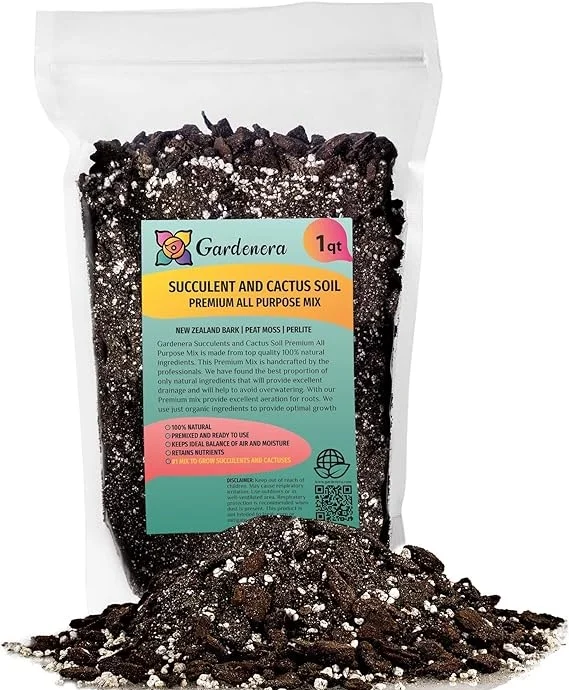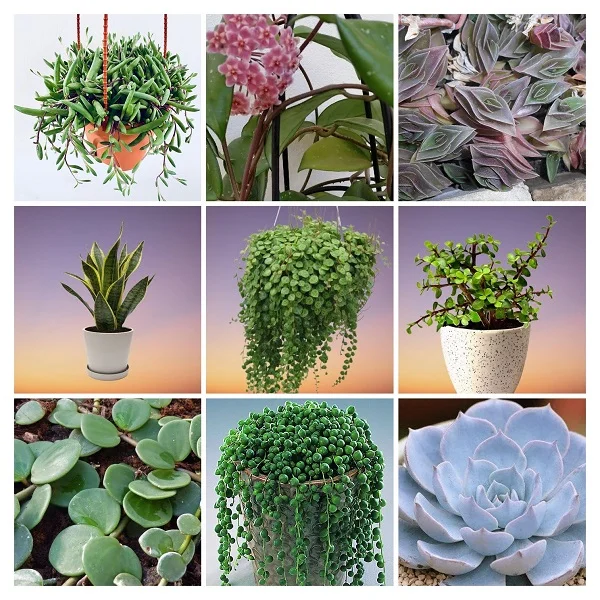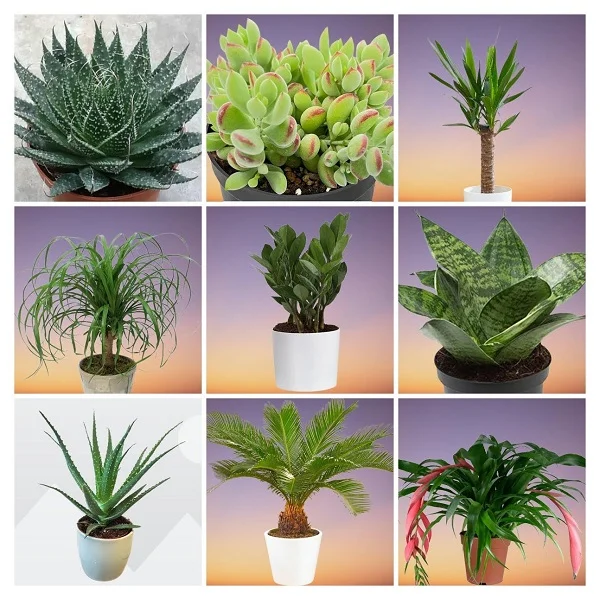Tiger Jade Crassula (Crassula picturata) Indoor Care, Propagation, Common Issues & Remedies
Some links in this post may be affiliate links
Crassula picturata (Tiger Jade Crassula) thrives in bright light with some sunlight, average warmth and humidity and moderately moist, well-drained soil coupled with monthly feeding in spring and summer.
Crassula picturata is among the popular Crassula varieties and bears numerous stems on which are borne triangular, dark-green leaves with red spots and purple undersides.
Tiger Jade Crassula is a perennial succulent shrub whose leaves are spirally arranged on the stem and usually develop a pinkish tinge in bright light or under direct sunlight placing it among the sun-loving plants ideal for a sunny spot.
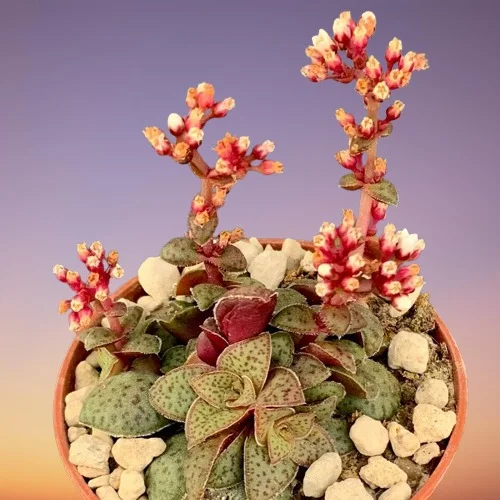
Botanical name: Crassula exilis subs. picturata
Family: Crassulaceae
Common names: Tiger Jade Crassula
Origin
Crassula picturata is native to Eastern Cape Province of South Africa where it is found growing in dense mats or cushions in crevices and soil pockets on vertical or steep rocks faces.
Flower
Tiger Jade Succulent blooms from late summer to fall with white and pink flowers which have a musty honey-like fragrance. The flowers are borne on a tall, hairy, terminal flower-stalk.
Size
Tiger Jade Crassula grows to a height of about 1 ft and bears numerous plantlets at the base of the woody root stock which can be used to grow new plants.
Is Crassula picturata toxic?
Yes. Crassula picturata like its cousin, Jade Plant, is thought to be toxic to both humans and pets as outlined by ASPCA. If ingested it can cause nausea, vomiting and diarrhea. Keep the plant away from the reach of children and pets.
How to Care for Crassula picturata Indoors
To care for Crassula picturata indoors, give it bright light with at least 4-6 hours of direct sunlight, warmth of 15-260C, humidity of 50-55% and moderately moist, well-drained soil coupled with monthly feeding in spring and summer.
Tiger Jade Crassula requires repotting only when pot-bound or when the potting medium is completely broken down. Pruning is necessary to keep the plant neat, to reduce pest and disease infestations and to rejuvenate growth. Keep reading for more on these growing conditions and how to achieve them.
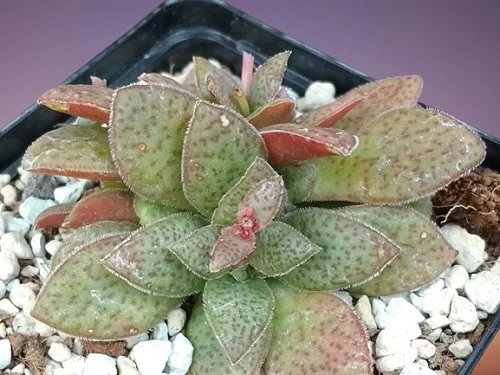
Watering
How to water Crassula picturata?
Water Crassula picturata liberally in spring and summer and allow the top 2-3 inches of soil to dry out between waterings. Take care not to overwater to avoid rotting, yellowing and leaf loss.
Cut down on watering in fall and winter as growth is minimal at this time, thus, the plant does not need a lot of water for growth. Do not leave the soil to dry out completely for long periods as it can cause wilting, drooping, yellowing and leaf fall.
Only use room temperature water to avoid cold shock as it can result in reduced growth, brown leaf spots and leaf drop. Ensure that the water is free of chlorine and other dissolved chemicals to prevent browning of leaves.
Ascertain that the pot has a drainage hole and the soil is fast-draining to prevent soggy soil as it can lead to rotting and death of the plant.
Take care not to wet the foliage to discourage fungal diseases; you may water from the bottom instead. Empty the bottom saucer (plate) once the plant has absorbed enough water to prevent sogginess of soil.
Light Requirements
Does Crassula picturata need sunlight?
Yes. Crassula picturata needs bright light with at least 4-6 hours of morning or afternoon sunlight. Keep it away from hot direct sunshine to prevent scorching of the leaves.
If the light is not enough, the plant will become leggy with elongated stems and yellowish undersized leaves. Where the natural lighting is not adequate, you may use full spectrum grow lights to supplement it.
Rotate the pot regularly to ensure that the plant receives light on all sides for uniform growth and to prevent lopsided growth.
You may also grow your Tiger Jade Crassula outdoors, but you will need to gradually acclimate it and place it in a shaded place first to prevent scorching of the leaves.
Temperature & Humidity
Crassula picturata flourishes in a warmth of 15-260C in spring and summer (growing season) and a minimum of 100C in fall and winter (cold season).
Keep the plant away from sources of drafts like breezy doors and windows, air conditioning units, hot air vents, heat sources among others as they can cause stunted growth and the death of the plant.
Tiger Jade Crassula has no need for extra humidity; a humidity of 50-55% is ideal for this plant. Do not mist the plant and ensure that there is good air circulation to prevent fungal disease infestations which are prevalent in damp, poorly aerated conditions.
Fertilizer
Crassula picturata is a slow grower, therefore, it does not need much fertilizer. feed it monthly in spring and summer with a cactus and succulents fertilizer to boost growth.
Withhold feeding in fall and winter as growth is reduced and feeding at this time can lead to fertilizer burn and eventual death of the plant.
To prevent browning of leaf tips and edges, regularly flush out excess salts by running a stream of water through the soil until it drains through the drainage hole. Let it run of some time to clear most of the salts.
Potting Soil
The best soil for Crassula picturata should be coarse, low in organic matter and one that drains fast to prevent it from getting soggy. The soil should be loose enough to allow water to drain out easily. Most Cactus and succulents mixes are ideal for this plant.
Repotting
Repot Crassula picturata at the beginning of the growing season (spring to early summer), only when pot-bound or when the potting medium has completely broken down.
Use a pot that is 1 size larger than the current one to avoid overpotting and retention of excess moisture. Confirm that the pot has a drainage hole to prevent the soil from getting soggy to prevent root-rot.
Select a clay pot rather than a plastic or ceramic pot as a clay pot is porous and allows the soil to dry out faster to keep it from staying wet for too long. Take a look at these terracotta pots with saucer on Amazon.
Before repotting, ensure that the soil is dry. Take the Crassula picturata out of its pot and brush off soil from the roots. Snip off any dead or dry roots and treat the wounds with a fungicidal solution.
Position the plant in the center of its new pot and back fill with fresh, loose, fast-draining soil while spreading the roots as you fill the pot.
Do not fill the pot completely but allow about 1 inch unfilled for watering space. Replace the plant to its display position and keep it dry for about 5-7 days to reduce the risk of rot-root disease.
Pruning & Grooming
Pruning Crassula picturata is easy as it involves removal of any dead or diseased leaves to keep it neat and also minimize pest and disease infestations. Snip the leaves at the base with a sterilized knife or pair of pruning scissors to prevent diseases transmission.
Cutback the plant at the beginning of the growing season (spring to early summer), if it is has become too large and unruly to encourage a compact growth. Minimize the number of cuts as much as possible to avoid unnecessary injuries to reduce fungal disease infestations.
Keep the leaves clean with a soft brush to get rid of dust and also discourage pest infestations.
Crassula picturata Propagation
Crassula picturata (Tiger Jade Crassula) is propagated from offsets, stem cuttings or leaf cuttings. The best time to propagate at the beginning of the growing season (spring to early summer) when it is in active growth for faster establishment.
1. Propagating Crassula picturata from offsets
- Carefully seperate the offset from the mother plant by cutting with a clean, sharp knife while ensuring that the offset has adequate roots.
- Fill a small pot one thirdway with a well-draining soil and moisten it slightly.
- Position the offset in the center of the pot and continue to cover the roots with the soil while firming the soil lightly. Maintain the offset at the same soil level as it was in the previous pot.
- Place the set-up in a warm, well-lit place away from direct sunlight to prevent scorching.
- Maintain good air circulation to discourage fungal diseases.
- Keep the soil slightly moist through out until the new plant is well established after which you can begin routine care.
2. Propagating Crassula picturata from stem cuttings
- Take 3-5 inches stem cuttings from a healthy plant and allow the cutting to dry out (callus) for a few days to prevent rotting.
- Fill a small pot with a fast-draining soil and moisten it slightly. Use a pot with a drainage hole to avoid rotting.
- Once callused, insert 2-3 inches of the lower cut end of the stem cuttings in the moist soil.
- Place the set up in a well-lit, warm place away from direct sunlight to prevent scorching.
- Ensure good air circulation to discourage fungal diseases.
- Maintain the soil slightly moist until the stem cuttings have rooted. Rooting may take upto 4 weeks.
- Allow substancial growth before transplanting the new plant into a pot one size larger after which you can begin routine care.
3. Propagating Crassula picturata from leaf cuttings
- Take leaf cuttings complete with the petiole from a healthy plant. Allow the leaf cutting to dry out (callus) for a few days to prevent rotting.
- Fill a rooting container with a fast-draining soil and wet it slightly. Ensure the container has a drainage hole to avoid rotting.
- When calloussed, lay the leaf cutting on moistsoil while ensuring that the cut end does not come into contact with the soil to prevent rotting.
- Postion the set up in a warm, well-lit place away from direct sunlight to prevent scorching of the leaf cuttings.
- Maintain the soil slightly moist through out and ensure that there is good air circulation to prevent fungal diseases.
- With time, the leaf cutting will form roots and eventually a small rosette will form at the base of the leaf cutting. This may take from 4-6 weeks.
- Allow substancial growth of the rosette before transplanting the new plant into its own pot after which you can begin routine care.

Crassula picturata Problems & Solutions
Crassula picturata (Tiger Jade Crassula) common issues are plant dying, leaf drop, leggy growth, pests and diseases among others. Keep reading for more on these problems and how to fix them.
Plant dying
Why is my Crassula picturata dying?
Your Crassula picturata is dying due to root-rot which is prevalent in soggy soil. The disease is characterized by yellowing and wilting of the leaves which is rapidly followed by browning and plant collapse.
How to fix it
- Carefully slip the plant out of its pot and inspect the roots; brown-black mushy roots indicate root-rot.
- Trim the rotten roots and treat the healthy roots with a copper-based fungicidal solution as indicated by the manufacturer.
- Repot the plant in fresh soil and a fresh pot. Use a pot with a drainage hole and fast-draining soil to prevent it from getting soggy.
- Place the plant in very bright light and stop watering for a few days to give the plant enough time to recover. After the dry period, resume routine care.
Leaf drop
Why is my Crassula picturata dropping leaves?
Your Crassula picturata is dropping leaves due to too little light, inconsistent watering, soggy soil, drafts, use of cold water, nutrients deficiency, pest infestations, excessive touching or aging.
How to fix it
Too little light: Position the plant in bright light with 4-6 hours of direct sunlight or use a grow light if you do not have enough light in your home.
Inconsistent watering: Do not water on a schedule. Water when the top 2-3 inches of soil dry out but never allow the soil-ball to dry out completely.
Soggy soil: Use well-draining soil and a pot with a drainage hole.
Drafts: Keep the plant away from drafts like windy doors, drafty windows, AC units, hot air vents among others.
Nutrients deficiency: Feed the plant with a cactus and succulents fertilizer every 4 weeks in spring and summer.
Use of cold water: Use water that is at room temperature to prevent cold shock.
Pest infestations: Regularly inspect the plant for pests and carry out timely control measures.
Excessive touching: Keep the plant away from the line of traffic and avoid unnecessarily moving it around and take care when moving it.
Aging: This is a natural process. As the lower leaves mature, they turn yellow, brown and eventually drop off.
Leggy growth
Leggy growth on Tiger Jade Crassula is caused by underwatering, insufficient light or nutrients deficiency.
How to fix it
Underwatering: Water when the top half of soil feels dry to the touch. Never allow the soil to dry out completely.
Insufficient light: Position the plant in bright light with 4-6 hours of sunlight or instal a grow light if the natural lighting is not enough.
Nutrients deficiency: Feed the plant with a cactus and succulents fertilizer every 4 weeks in spring and summer.
Pests
Common pests on Crassula picturata are scale insects, mealybugs and spider mites. Isolate the affected plant to prevent spread to the rest of plants.
How to fix it
- Isolate the affected plant to prevent spread to other plants.
- Treat the infested plant with neem oil or insecticidal soap as per the manufacturers' instructions.
- Check between the leaves for these pests and carry out timely control measures.
- Maintain the plant well pruned to discourage the pest infestations.
Diseases
Crassula picturata is prone to leaf spot disease and powdery mildew which are prevalent in overwet conditions coupled with poor air circulation.
How to fix it
- Isolate the affected plant to minimize spread to the other plants.
- Treat the affected plant with neem oil as per the manufacturer's recommendations.
- Maintain free air flow to discourage the diseases.
- Water from the bottom to avoid wetting the leaves.
- Always allow the soil to dry out between waterings.
- Use a pot with a drainage hole and fast-draining soil to prevent waterlogging.
You liked it? Share on social media.
Related Content
Amazon Associates Disclosure
Homeplantsguide.com is a participant in the Amazon Services LLC Associates Program, an affiliate advertising program designed to provide a means for sites to earn advertising fees by advertising and linking to amazon.com.

